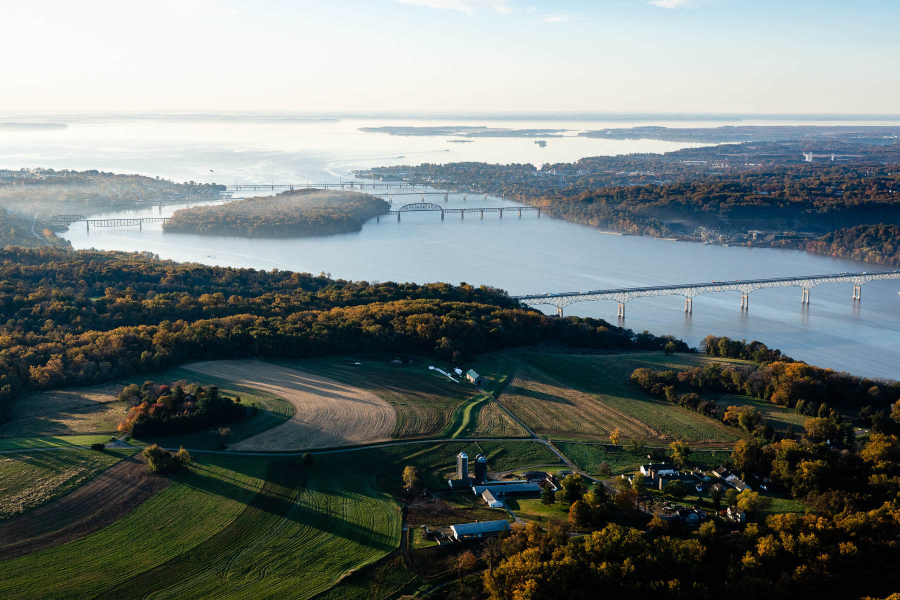Annual report spotlights the Chesapeake Bay Program’s continued restoration efforts
This year’s Bay Barometer gives an overview of nine environmental outcomes

The Chesapeake Bay Program’s 2021-2022 Bay Barometer covers nine outcomes that span the broad spectrum of restoration work happening across the partnership.
From restoring oyster habitat to tracking toxic contaminants in the water, these outcomes are the most recently updated targets from the Chesapeake Bay Watershed Agreement, a roadmap for Bay restoration that partners of the Bay Program signed in 2014.
The Bay Barometer provides the “status” of these outcomes—how they are doing compared to the previous reporting periods—as well as the outcome “trends”—which demonstrate the long-term progress made. Looking at the data from these two perspectives allows us to identify important changes, such as the sharp decrease in blue crab populations noted in 2022, while being aware of long-term trends, such as the continued increase in pollution reduction happening across the watershed.
Below is an overview of the outcomes you’ll find in the partnership’s annual report.
Outcome overview
Toxic Contaminants
In 2010, the partnership began tracking the number of tidal segments in the Chesapeake Bay that are listed as fully or partially impaired due to toxic contaminants. Since then, each biennial update has seen that number increase. In the most recent reporting period of 2018 that number reached 84%.
Underwater grasses
From 2018 to 2019, the number of acres of underwater grasses (or submerged aquatic vegetation) in the Chesapeake Bay took a huge hit. Underwater grasses dropped again from 2019 to 2020, though only slightly, and in 2021, the most recent reporting year, acreage increased by 7%. While more acres of underwater grasses were mapped in 2021 than the previous two years, the amount is still far lower than the highs reached in 2017 and 2018.
Blue Crabs
The Chesapeake Bay’s blue crab population was significantly less in 2022 than in 2021. Research from the Chesapeake Bay Stock Assessment Committee estimated that the population wasn’t being overfished, which indicates that there must be another reason for the sharp decline (a series of workshops are underway to better understand the issue). Though the 2022 population is well below the target of 196 million, it is above the 72.5 million threshold that is considered to be the minimum sustainable level for female blue crabs in the Bay.
Water Quality
Between 2018 and 2020, an estimated 29.6% of the Chesapeake Bay and its tidal tributaries met water quality standards. This score is lower than the previous 33.1% received during 2017 and 2019, and marks a consecutive decline in the assessment status since the record high of 42.2% achieved between 2015-2017.
Forest buffers
In 2020, 169 miles of forest buffers were planted along rivers and streams in the Chesapeake Bay watershed. While this is an increase from 2019 in which 83 miles of forest buffers were planted, it is 731 miles below the 900-mile-per-year target. Since 2010, the miles of forest buffers planted each year has averaged just 25% of the yearly restoration target that will help us reach our clean water goals.
Sustainable schools
Since 2015, the Chesapeake Bay Program has worked with public and charter schools within the watershed to become sustainably certified. The number of sustainable schools has increased each biennial update, except in 2021, when there were 9% less sustainable schools than in 2019. Experts believe the decrease is likely due to a decline in reporting during the COVID-19 pandemic.
Public access
In 2010, the Chesapeake Bay Program set a goal to open 300 new sites for people to access the Bay and its tributaries, adding to the 1,339 existing locations. The partnership is on track to meet this goal; in 2021, 31 new sites were opened which brings the total to 237 new access points.
Oysters
As of the end of 2021, the partnership has restored oyster habitat in six of 10 tributaries that were selected in the Oyster Outcome, in addition to an 11th bonus tributary, the Eastern Branch of the Elizabeth River. Restoration work is underway in the remaining four tributaries under this outcome and are expected to be completed by 2025.
Modeled Pollution Loads
Between 2020 and 2021, nitrogen, phosphorus and sediment pollution in the Chesapeake Bay watershed were estimated to have decreased 1.4 million pounds, 0.004 million pounds and 74.2 million pounds, respectively. While the sediment reduction from 2020 to 2021 is above the average for 2009 through 2020, nitrogen and phosphorus reductions for 2020 to 2021 are below average.
Partnership highlights
Beyond the numbers reported in these outcomes, the Bay Barometer includes an overview of various partnership achievements over the past year. Some of these highlights includes award-winning studies on nitrogen pollution, ground-breaking new data sets used to better target restoration, green infrastructure concepts developed alongside communities vulnerable to climate change and more.
Check out the 2021-2022 Bay Barometer here.

Comments
There are no comments.
Thank you!
Your comment has been received. Before it can be published, the comment will be reviewed by our team to ensure it adheres with our rules of engagement.
Back to recent stories